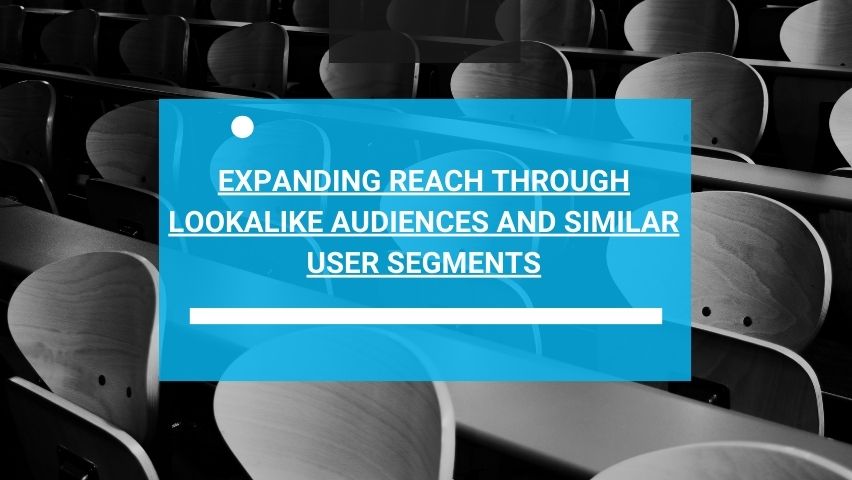Ready to Elevate your Marketing Strategy?
In the competitive realm of online gambling advertising, the ability to connect with the right audience is the linchpin of success.Lookalike audiences emerge as a potent tool, allowing advertisers to broaden their horizons by targeting individuals who share traits with their existing customers. In this article, we delve into the concept of lookalike audiences and their pivotal role in online gambling advertising. We unravel the intricacies of crafting these audiences, explore their performance in ad campaigns, and illuminate how they synergize with personalization for optimal outcomes. Additionally, we underscore the significance of data privacy and user consent in wielding lookalike targeting strategies responsibly.
Understanding Similar Audiences
Lookalike audiences comprise individuals who share resemblances in traits and behaviors with an advertiser’s current customer base. These audiences are curated using data analytics and machine learning, spotlighting patterns and attributes common among a brand’s most valuable patrons. By directing efforts toward lookalike audiences, advertisers can extend their outreach beyond their established clientele, engaging potential new customers who are predisposed to harbor genuine interest in their offerings.
Crafting Lookalike Audiences for Gambling Advertisements
The process of constructing similar audiences commences with the formulation of seed audiences, a subset drawn from the existing customer pool.
- Advertisers wield data touch points such as demographics, interests, online conduct, and previous gambling interactions to weave these seed audiences.
- Employing advanced algorithms, ai in advertising platforms then discern other users whose characteristics parallel those of the seed audience, resulting in the formation of a comprehensive lookalike audience.
- A staggering 76% of marketers affirm that lookalike audience targeting is the paramount method for nurturing campaign engagement and bolstering ROI.
- Expanding reach through lookalike audiences and similar user segments can significantly amplify the impact of dynamic creative optimization (DCO) in gambling advertising, especially when aligned with Google Performance Max Campaigns.
Best Practices for Testing Lookalike Audiences
When working with lookalike audiences, it’s crucial to test different audience segments to find the best performing ones. Here are some best practices for optimizing your tests:
Start with High-Quality Source Audiences
Ensure your source audience is made up of high-converting, loyal customers.
- The more precise your seed data, the better the lookalike audience will perform.
- Platforms like Facebook allow you to create lookalike audiences ranging from 1% to 10% of a given population.
- Start with smaller percentages (1-3%) for higher similarity and gradually expand to see how broader audiences affect conversions.
A/B Test Creative Variations
Run multiple ad creatives to see which resonates best with each lookalike audience.
- Test different messaging, visuals, and CTAs to ensure your ads appeal to the unique behaviors and preferences of each segment.
- See which elements work for you and what dosen’t. Use this to inform future campaigns.
Experiment with Campaign Objectives
Set specific objectives for each test.
- For example, test one lookalike audience for lead generation while targeting another for conversions. This helps determine which audience is most effective for each campaign goal.
- Track key metrics like click-through rates (CTR), cost-per-click (CPC), and conversion rates to evaluate the effectiveness of your lookalike audiences.
- Use these insights to refine your targeting and campaign strategy. Staying on top of your performance metrics can provide insights for improving your campaign performance.
- Also it helps for creating benchmarking for your future ad campaigns, or for comparing against your competitors.
Exclude Existing Customers
To avoid overlap and maximize ad spend, exclude your current customers from lookalike audience targeting.
- This ensures that your ads are reaching new potential customers who resemble your existing base.
- It also provides information on how much marketing budget is spent on targeting already converted audiences.
Testing lookalike audiences through segmentation, audience sizes, and creative variations helps refine your strategy. It also helps achieve better results. By continuously optimizing based on performance data, you can increase the effectiveness of your lookalike campaigns and reach new, high-value customers efficiently. Start implementing these pointers and maximise your marketing performance.
Performance of Lookalike Audience
A salient advantage of leveraging lookalike audiences resides in their exceptional performance compared to alternate targeting techniques.
- By zeroing in on users who mirror existing customers, advertisers heighten the prospect of ad relevance and resonance.
- Lookalike audiences frequently exhibit elevated rates of engagement and conversions, rendering them an efficacious instrument for broadening reach and propelling success in gambling ad endeavors.
- The integration of similar audiences can instigate a notable 58% hike in click-through rates in contrast to traditional targeting approaches, which aligns seamlessly with Digital Public Relations Marketing
Extending Reach to Novel Markets
Lookalike audiences hold the potential to be harnessed for venturing into unexplored markets or demographics.
- For gambling operators eyeing entry into fresh territories, fashioning lookalike audiences grounded in their extant customer base empowers them to unearth potential patrons in the new market who share akin interests and behaviors.
- Advertisers can then tailor their ad communiqués to cater to the predilections of this untapped audience.
- A substantial 85% of companies that deploy lookalike targeting report marked enhancements in their endeavors to acquire new customers.
Synergizing Lookalike Audiences with Personalization
For an augmented stride in the realm of lookalike audience targeting, amalgamating this approach with personalization strategies is recommended.
- The implementation of dynamic creative optimization (DCO) bestows the capability to furnish personalized ad experiences across diverse segments, including lookalike audiences.
- By calibrating ad content based on user predilections and actions, advertisers can augment engagement, augmenting the likelihood of conversions.
- Personalized ads founded on lookalike audience targeting can usher in a substantial 50% escalation in conversion rates.
Advanced Targeting Strategies with Lookalike Audiences
Using advanced targeting strategies with lookalike audiences can significantly refine your campaigns. By focusing on behaviors, demographics, and actions, you can better tailor your marketing.
Behavior-Based Targeting: Segment lookalike audiences based on behaviors such as recent purchases, website engagement, or specific actions (e.g., signing up for newsletters). This allows you to target users who mimic valuable behaviors, such as those with higher purchase intent.
Demographic Refinement: Layer demographic targeting (e.g., age, location, income) over your lookalike audiences to ensure your ads reach individuals who match not only behaviors but also ideal customer profiles. For example, targeting high-income segments from a luxury goods source audience can lead to higher conversions.
Engagement-Level Targeting: Build lookalike audiences based on highly engaged users, such as those who frequently interact with your social media or spend significant time on your website. Engagement-level targeting ensures your ads reach users more likely to interact and convert.
Product or Category Focused Audiences: Create lookalike audiences from users who have shown interest in specific product categories. If certain users frequently purchase electronics, you can build a lookalike audience specifically targeting similar users likely to engage with electronics-related ads.
Event-Based Audiences: Use custom event data from your website (e.g., users who completed a form, watched a video, or added items to a cart) to create more refined lookalike audiences. Targeting based on these specific events allows for more customer acquisition.
Geolocation Targeting: Combine lookalike audiences with geographic targeting to promote local campaigns. If you’re targeting specific regions or cities, you can refine your lookalike audience to focus on users who resemble your best customers in those locations.
By refining your strategy with behavior-based segmentation, demographic overlays, and event data, you can increase the likelihood of reaching the right audience with your ads, leading to higher conversions and greater ROI.
Data Privacy and Consent
Amid the array of benefits that lookalike audience targeting proffers, the safeguarding of data privacy and consent claims paramount importance.
- Compliance with data privacy regulations stands as a non-negotiable imperative when harnessing customer data to shape lookalike audiences.
- Obtaining user consent for data utilization and ad targeting is indispensable, fostering trust and engendering transparency with the audience.
- A noteworthy 57% of consumers extend willingness to share their data when a brand commands their trust and presents reciprocal benefits.
Conclusion
Lookalike audience targeting materializes as a valuable avenue for online gambling advertisers to broaden their horizons, escalate engagement, and amplify conversions. The fusion of data analytics and machine learning empowers advertisers to unearth and target users who mirror the characteristics of their existing clientele. The meshing of lookalike audience tactics with personalization lends wings to ad performance, offering users personalized journeys that resonate with their inclinations and preferences. It’s vital, however, to uphold data privacy and secure user consent as pivotal pillars in the process, fostering transparency and nurturing trust. Armed with the right approach, lookalike audience targeting can unfurl a transformative chapter for online gambling advertisers, unraveling new horizons and catapulting theirg advertising endeavors to elevated pinnacles aided by Paid Pragmatic Marketing strategies.
FAQs
A lookalike audience is a group of users who share traits and behaviors similar to your existing customers. It’s created using data analysis and machine learning techniques to find patterns that are common among your most valued patrons.
To build a lookalike audience, you start with a seed audience composed of a subset of your current customers. Use data points such as demographics, interests, and past interactions to form this seed group. Algorithms then identify users with similar characteristics to expand the audience
Yes, lookalike audiences are highly effective. By targeting users who resemble your existing customers, you increase the likelihood of ad relevancy and engagement. Lookalike audiences often exhibit higher engagement rates, making them a powerful tool in ad campaigns.
Absolutely, platforms like Facebook and LinkedIn offer lookalike audience features. These platforms analyze user data to identify profiles that resemble your seed audience, allowing you to extend your reach and connect with potential customers who share characteristics with your current ones.
Lookalike audiences can be instrumental when entering new markets. Creating lookalike audiences based on your current customers. Identify potential customers in the new market who are likely to be interested in your offerings. This helps tailor your ad messages for maximum impact.



